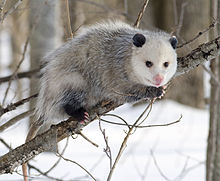The Scribe Valdemir Mota de Menezes in December 2011 found this saru killed in the area of the house in the Garden of Eden . As this day the dogs were in place, I suspect that one of the dogs killed.
-----------------------
From Wikipedia, the free encyclopedia
For the Eastern Hemisphere marsupial, see possum.
| Didelphimorphia[1] Temporal range: Late Cretaceous–Recent | |
|---|---|
 | |
| Virginia Opossum Didelphis virginiana | |
| Scientific classification | |
| Kingdom: | Animalia |
| Phylum: | Chordata |
| Class: | Mammalia |
| Infraclass: | Marsupialia |
| Order: | Didelphimorphia Gill, 1872 |
| Family: | Didelphidae Gray, 1821 |
| Genera | |
| Several; see text | |



Nenhum comentário:
Postar um comentário